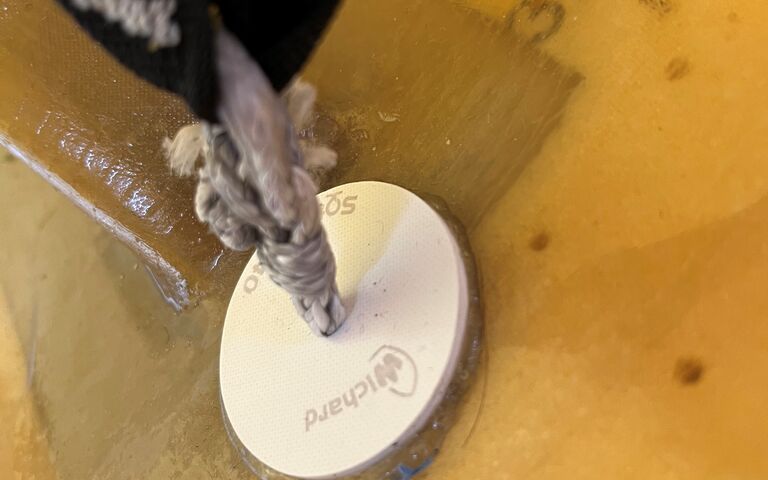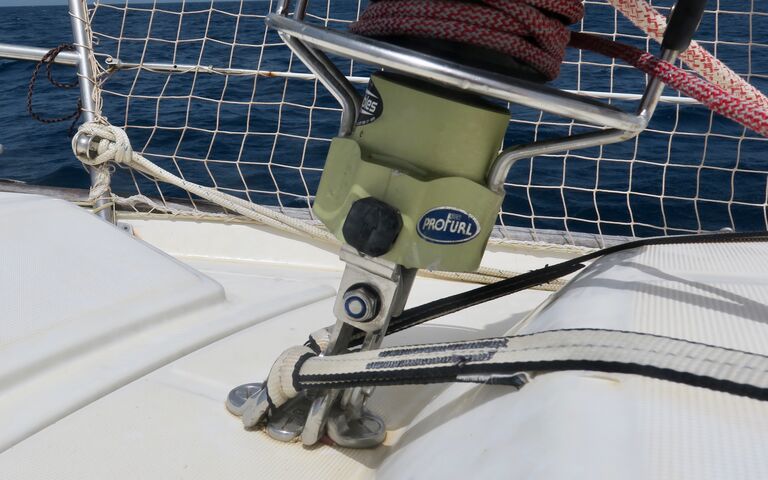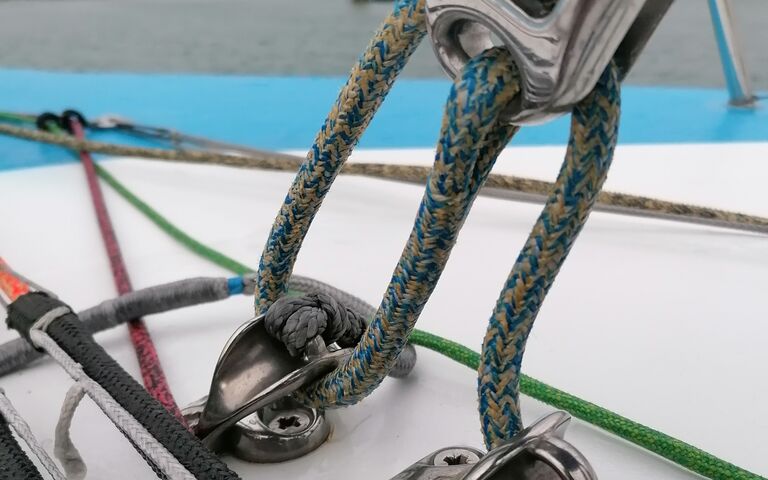A padeye is a fastening element on a boat, commonly used for anchoring or securing the various fittings to the deck of both power boats and sailboats. Wichard padeyes are available in a wide range of sizes and configurations, each featuring the quality and reliability that comes from over 40 years of experience designing and manufacturing the best hardware for every application.
From the historic folding stainless steel padeye to the new and lightweight stick-on padeye, this article will take a look at Wichard’s comprehensive range of padeyes.
1. Padeyes for all boats, for over 40 years
At Wichard, we are proud to say that we began designing our first padeyes in the 1970s. This was a turning point for the company, as from that point onwards we worked alongside great sailing figures such as Éric Tabarly, Bernard Moitessier and Alain Colas to develop all types of sailboat fittings. These product ranges proved to be an important addition to our portfolio, which had specialised primarily in the manufacture of forged safety products since our company founding in 1919.
Through research and development, several ranges were created:
- Folding padeyes, in 1988 (later updated in 2016)
- U-bolts, in 1991
- Watertight padeyes, in 1992
- Double folding padeyes, in 1993
- Two-point folding padeyes, in 1997
- Fixed diamond-shaped padeyes in 2021
- Heavy-duty round and wire padeyes, in 2023
- Stick-on padeyes, in 2024.
More than forty years after the creation of our first padeye, Wichard has succeeded in its mission to equip the boats of entire generations of sailors, all over the world. Today, Wichard padeyes are some of the most widely used padeyes on the market, found about vessels of all sizes and trusted by the most prominent boatyards. The Wichard padeye is now an essential piece of equipment on every boat.
2. Wichard innovates with its new range of stick-on padeyes (Softeye)
To complete our padeyes offering, we recently developed a more modern, complementary product. Introducing the new Wichard stick-on padeye, also known as the Softeye. Suitable for a variety of applications, the Softeye is strong, lightweight, and easy to install without the need to drill any holes.
In place of a traditional stainless-steel construction, the stick-on padeye utilises the durability and strength of a Dyneema® loop as the primary fixing point. The mounting base is constructed from fibreglass, and can be installed using polyurethane or polymer sealant for temporary applications or using epoxy for a permanent fixture. In addition to the low weight and ease of installation, softeyes are inherently flexible (self-aligning with load) and pose no risk of corrosion. Available in either black or white, they are well-suited for countless light to medium load applications for deck fittings, or even hanging miscellaneous equipment such as fenders.
3. Our various ranges of padeyes and their specific features
Various types of padeyes were developed and manufactured in the Wichard workshops. Each range has unique technical features and is appropriate for different applications.
a ) Single or double folding padeyes
The folding padeye is a long-standing Wichard product: also known as an ‘articulating padeye’, the range was first launched in the 1980s and is perhaps the most familiar type of padeye to sailors.
- It is now available in 4 single and 3 double models, to suit all uses. These include:
- The single 2-point folding padeye is often used to attach a harness lanyard when leaving the cockpit.
- The 3-point folding padeye is a universal product that can be used, for example, to attach a lifeline or a pulley block.
- The double padeye is regularly used to fit a removable forestay or to attach multiple shrouds.
- There's also what's known as the ‘folding padeye with fairlead, which takes up the tension of a furler by running a rope through the padeye.
When laying flat, the folding padeye is discreet. Not only is it aesthetically pleasing, it also offers greater safety: on board: the crew can walk on it without risking injury! The silicone blocking pad integrated in the product prevents vibrations and unwanted rattling.
The Wichard folding padeye is available in several materials. Choose between stainless steel, HR 17.4 PH, or 316L stainless steel. With a forged padeye, users have access to high working and breaking loads, regardless of the angle of pull. Its protection against corrosion is also remarkable. The folding titanium padeye is ultra-light: with a diameter of 6, 8 or 10 mm, it is recommended for use in high level competition.
Finally, some models are designed and manufactured to comply with ISO 15085: 2003 standards for small craft man -overboard protection, including part numbers 6604, 6605 and 6606 3-point folding padeyes.

b ) U-bolts
The u-bolt has many uses onboard a boat. It can be used, in particular, as a bow fitting on small craft or on Personal Watercraft. On sailboats, it is also suitable for attaching shrouds, lifelines or pulleys.
U-bolts are made of 316L stainless steel and have particularly high working and breaking loads.
The Wichard range of u-bolts span diameters from 4mm to 12 mm, and lengths from 50mm to 130 mm, providing size ranges appropriate for a large range of applications and boat sizes.
c ) Watertight u-bolts
The Wichard watertight u-bolt was launched in 1992. Like the u-bolt, it is often used on small powerboats as a bow chainplate. It can also be used to attach guy wires, lifelines or pulleys.
Watertight u-bolts boasts remarkable working loads and breaking strengths. With its UV-resistant elastomer pad, the fittings ensure a perfect seal, without the need for a gasket.
Available in black or white, models from 5mm to 12 mm in diameter and 60mm to 130 mm in length are available. All waterproof u-bolts are supplied with a backing plate and two locknuts.

d ) Fixed padeyes
Since 2021, Wichard has offered various ranges of fixed padeyes, suitable for all onboard uses. Options include fixed diamond-shaped padeyes with a round or square hoop, and fixed round padeyes with a round hoop.
d. 1 ) Fixed diamond-shaped padeyes
The fixed diamond-shaped padeye is a space-saving piece of equipment: several padeyes can be fitted side by side, ensuring that the user takes up minimal space on board. Once again, this range of padeyes can be used in a wide variety of situations: for a mast step return, for a block deviation, for reefing lines, and more.
Two styles are available for the hoop: the square hoop is ideal for metal fasteners, while the round hoop is appropriate for textile fasteners. Both styles of fixed diamond-shaped padeye are available in three sizes: 60 mm, 79 mm, or 98 mm. In all cases, duplex stainless steel offers a very good ratio between mechanical strength and corrosion resistance. M5, M6 or M8 screws are required for installation.
d. 2 ) fixed round padeyes
Made from the same material, the fixed round padeyes are designed for heavy loads. Perfect for use in a various high-load applications, such as reefing lines, tacklines on a bowsprit, for a pulley return, and securing running backstays.
Wichard's fixed round padeyes are available in three sizes, with diameters of 57 mm, 76 mm, or 95 mm, and are fastened using M6, M10 or M12 screws.
4. Our commitments to Wichard padeyes: quality and safety
As with all our equipment, we are committed to ensuring the very best for all our padeyes. All our models meet Wichard quality standards, which are particularly demanding in terms of safety.
Padeyes in stainless steel or other materials
Proper material selection is critical, so Wichard uses different grades of stainless steel to take advantage of their unique properties. In padeyes, 316L stainless steel provides excellent corrosion resistance, 17.4 PH provides the highest mechanical strength, and duplex stainless steel provides a good compromise between the two previous materials.
Other materials such as titanium or fibreglass and Dyneema® are used for specialist padeye models. Regardless of the material selection or the manufacturing process, every raw material supplier is carefully selected at national or European level.
A manufacturing process adapted to future use
Thanks to Wichard’s historic expertise in forging, some padeyes are made from heated stainless steel bars. This manufacturing process gives each forged padeye excellent mechanical strength and corrosion resistance. Other padeyes are produced using a bending or casting process.
Rigorous procedures and controls
Whether a padeye is made from stainless steel or another material, there are several crucial stages in the design of the equipment:
- When received, the materials are systematically checked to ensure their quality.
- During product development, we apply a safety factor. Thanks to this, the padeye will offer its user a margin of safety when used within its stated working load.
- At the end of production, each batch is subjected to tensile tests. This way, we can guarantee all products comply with breaking and working loads.
- Finally, a salt spray test is carried out to check the finished product's resistance to corrosion.
Would you like to find out more about Wichard's padeyes, or would you like some help choosing your deck hardware? Let one of the dealers in the Wichard network guide you:

